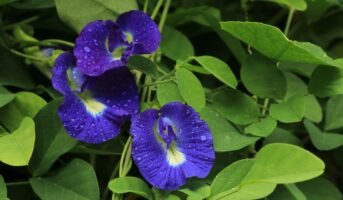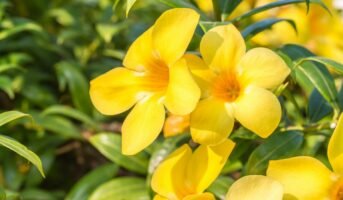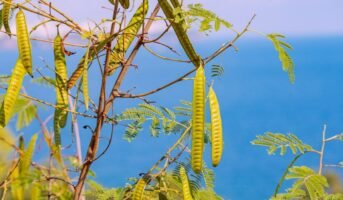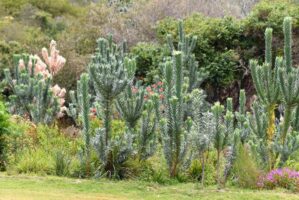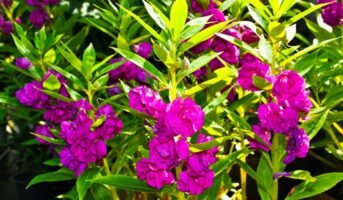What is Kurinji?
Kurinji plants are extremely special due to their rare nature of flowering every 12 years. These plants are mostly found in India and South Asia in cooler climates. There are over 150 varieties of Kurinji flowers in the world like the Strobilanthes cuspidatus that bloom once in seven years. Once they die, their seeds sprout and the plant again blooms.
Kurinji is known as Neelakurinji in Tamil and Malayalam and is one of the most popular species that predominantly grows in South Indian hills. The Kurinji shrubs are mostly found in hilly areas in large pastures and meadows. Kurinji shrubs are a top tourist attraction for people in and around India.

Source: Pinterest
See also: Sauropus androgynus: Katuk edible uses and health benefits
Kurinji plants are small shrubs that rarely grow above 24 inches in height. They are bushy shrubs that flower in big intervals. They can sometimes take longer than 12 years to produce flowers. Kurinji flowers are mostly found right after the monsoon season. The plant sports trumpet-like flowers that mostly come in pinkish hues
Also see: All about Katuk
Kurinji: Key facts
| Name | Kurinji |
| Common names | Neelakurinji |
| Scientific name | Strobilanthes kunthiana |
| Flowers | Light purple |
| Soil | Red and black soil |
| Temperature | 24 to 35°C. |
| Water | Moderate |
| Sunlight | Plenty |
| Blooming time | Once in 12 years |
| Type | Flowering shrub |
Kurinji: How to grow
Kurinji flowers are mostly found in the wild. Very few people plant them at home because they don’t produce blooms every year. Their year of blooming is extremely unpredictable, and no one really wants to have them at home just to wait for 12 years for flowers. However, plant enthusiasts like having the Kurinji plant at home as a rare collection.

Source: Pinterest
Kurinji: Care tips
If you are someone who is thinking of having a Kurinji plant at home, here are some care tips to help you with growing them.
Soil
Kurinji flowers grow best in mountain soil. You can use red soil or black soil for this plant. Normal garden soil mixed with perlite will be best. Make sure the soil is well drained. You can add wood chips and bark to make it more porous. You can fertilise them every spring or when buds are seen on the Kurinji plant.
Water
Kurinji plants need to be watered when the topsoil has dried. The soil should be more or less moist but not completely soaked in water. Avoid over-watering them when the soil is moist. The waterlogging problem will kill Kurinji plants, so be careful to avoid that.
Sunlight
Kurinji flowers grow best in full sunlight. However, if you stay in a very hot climate, you can consider growing them in semi-shaded areas. Kurinji plant needs plenty of morning sunlight for at least 4-5 hours. They grow in huge pastures in the hills, so lots of sunlight is required if you are growing them in cooler climates.
Kurinji: Benefits
Kurinji flowers are a major tourist attraction in South India. Their beautiful purple flowers and rarely blooming nature attract a lot of people, and many have attempted to plant them at home. However, Kurinji flowers are not just meant for ornamental purposes.
They have a wide variety of health benefits that make them extremely beneficial for the body. Kurinji honey is a popular product used for its medicinal value.

Source: Pinterest
Here is a list of health benefits that can be traced back to Kurinji extracts:-
Treats anaemia
Kurinji is used in Ayurveda to provide medicines and treatment for anaemia. Anaemia occurs when blood haemoglobin levels drop significantly. Honey from Kurinji flowers is said to have a high amount of iron that can help in blood regeneration and reduce the risk of anaemia.
Relieves pain
Kurinji extracts are said to have anti-inflammatory properties that can help relieve pain. It is especially good for curing abdominal pains and stomach pains. It can reduce the inflammation of infected or damaged areas to provide relief from pain.
Great for postnatal care
Kurinji is filled with a wide variety of nutrients that can help replenish the body’s need for them. It is exceptionally good to consume for postnatal care. New mothers undergo extreme blood loss and feel weakness. Since Kurinji honey can help in blood regeneration, it can be beneficial for postnatal care for women.
Improves immunity
The rich nutrient content of Kurinji honey makes it an excellent product for strengthening immunity. It helps the body to restore the balance of nutrients and prevent it from catching chronic diseases. It can also lower the risk of getting coughs and colds frequently.
Kurinji conservation
As the flower blooms once in 12 years, the Kurinji plants in its core habitat in Kerala’s Kottakamboor and Vattavada villages are protected by the Kurinjimala sanctuary. Also, the Kurinji Andavar temple that is present in Kodaikanal, Tamil Nadu protects the Kurinji plants.
FAQs:
Why does the Kurinji flower bloom in 12 years?
Kurinji flowers take a lot of time to get pollinated. This is why they flower after 12 years.
How long will the Kurinji flower last?
Kurinji flowers last for about one month after blooming. They bloom once every twelve years.
What is special about Kurinji?
Kurinji flowers are famous because they rarely bloom. Each tree blooms every 12 years, and no flowers are seen in these gap years.
What is the taste of Kurinji?
Kurinji is black and thick akin to molasses and it tastes a little bitter with a dash of sweetness.
Is Kurinji poisonous?
The leaves of Kurinji are poisonous and are unfit for human consumption, but they’re used in the preparation of medicines as a herb.
Housing News Desk is the news desk of leading online real estate portal, Housing.com. Housing News Desk focuses on a variety of topics such as real estate laws, taxes, current news, property trends, home loans, rentals, décor, green homes, home improvement, etc. The main objective of the news desk, is to cover the real estate sector from the perspective of providing information that is useful to the end-user.
Facebook: https://www.facebook.com/housing.com/
Twitter: https://twitter.com/Housing
Email: [email protected]

